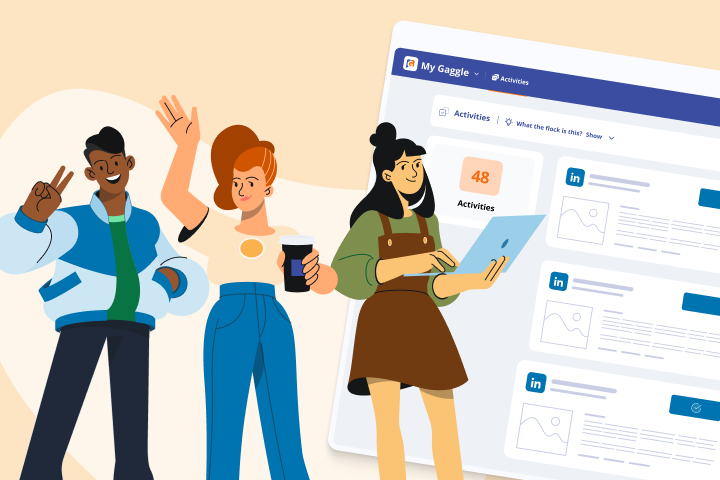Employee engagement in the U.S. has dropped for the first time in over a decade. Fewer employees are engaged in their work and even more are actively disengaged.
These new trends in employee engagement aren’t just a concern for HR — they’re a concern for company leadership. As a result, an impactful employee engagement strategy is now more important than ever.
Why should you take a thoughtful approach to employee engagement? Employee engagement is a competitive advantage that sets excellent companies apart from others. Employees who are engaged in their work have a better sense of well-being and are more satisfied in their jobs. And companies with an engaged workforce achieve better business results.
What Is Employee Engagement And Why Is It Important?
Employee engagement describes the connection employees have to their employer and how committed employees are to their work and workplace.
Some of the main drivers of employee engagement include:
- Trust in leadership
- Aligned values
- Meaning and purpose
- Effective communication
- Recognition and praise
- Strong work relationships
- Learning and development opportunities
Levels of employee engagement can vary from employee to employee. But how do you tell the difference between an engaged employee and one who is disengaged? Here are a few of the mindsets and behaviors often demonstrated by engaged and disengaged employees to help distinguish the two.

Engaged employees:
-
Have faith in the company, company leaders, and management.
-
Believe in the company mission.
-
Have a deep connection to the work they do.
-
Demonstrate a passion for learning and growth.
-
Go above and beyond in their work.
Disengaged employees:
-
Have a negative opinion about the company, company leaders, and management.
-
Doubt the company mission.
-
Feel disconnected from the work they do.
-
Have a negative outlook on their work and growth opportunities.
-
Are more likely to be absent from work and/or disruptive in the workplace.
Employee engagement is not synonymous with employee satisfaction and employee happiness. Instead, employee satisfaction and happiness are the result of employee engagement.
The more engaged an employee is, the happier and more satisfied they are. Strategies that boost employee engagement often result in a wide range of benefits.
Benefits of Employee Engagement
Employee engagement is beneficial to multiple organizational stakeholders. When a workforce is highly engaged, employees, customers, and employers benefit.
1. Employee Retention
It’s no secret that employee retention is preferred over employee turnover. And retaining top talent is key to company success.
When you have a workforce of engaged employees, the less time, money, and resources you have to dedicate to the talent pool with sourcing, hiring, and training new employees. Engaged employees are more likely to stay in their jobs while disengaged employees are more likely to leave their roles.
Employees are less likely to turnover when they receive recognition for their work, have opportunities for career development and personal growth, and have a clear understanding of the company’s values and goals.
2. Productive Workforce
When Gallup compared business units that ranked low in employee engagement to those that rank higher in employee engagement, the highly engaged units saw an 81% decrease in absenteeism and an 18% increase in productivity.

Why does a highly engaged workforce result in increased productivity? Workers who are actively disengaged have higher rates of absenteeism which means the work isn’t getting done.
Your company will have a better chance of achieving its business goals when the majority of the workforce is engaged in the work they’re doing.
3. Connected Teams
Managers are a critical factor in employee engagement. According to Gallup, “employees who receive daily feedback from their manager are three times more likely to be engaged than those who receive feedback once a year or less.”
Frequent, meaningful feedback creates an important line of communication between employees and managers. This communication allows managers to foster an environment where employees feel they’re valued and care about the outcomes of their work and the success of their team.
4. Safer Workplaces
Employee safety and well-being in the workplace should come first and foremost. The more engaged employees are, the less likely that there will be serious safety incidents and injuries.
A Gallup survey found that teams that reported higher levels of employee engagement saw a 64% decrease in safety incidents when compared to those with less engaged employees.

5. Happier Employees
Employee happiness goes beyond physiological and safety needs. Yes, these crucial needs must be met but there’s so much more that contributes to happiness in the workplace.
Engaged employees are often happier because:
- Their work is acknowledged and they feel appreciated.
- They have professional development opportunities.
- They have strong connections with their managers and colleagues.
- There’s meaning and purpose behind the work they’re doing.
Not only are engaged employees happier, but they’re also more satisfied with their jobs.
6. Employee Advocacy
Engaged employees feel a connection to the mission and values of their employer and are enthusiastic about their jobs. Satisfied employees can be meaningful advocates for your company.
When they’re passionate about where they work and the work they do, employees are often vocal and will share company content on social media.
This type of promotion is important because employee advocacy helps you attract new business and talent to your company. Plus, it extends your brand reach in a more authentic and cost-effective way than traditional marketing and advertising.
7. Satisfied Customers
Customer satisfaction or dissatisfaction can impact your company’s bottom line. The “State of the Connected Customer” report found that 91% of customers are more likely to make another purchase after a great service experience.
Let’s see how employee engagement impacts the customer experience. For example, let's say the majority of the members of your customer support team are actively disengaged. How would the quality of the service they provide to customers be impacted?
If employees don’t feel a strong connection to your company or its mission, it’s unlikely that they’ll care deeply about the success of your customers. On the other hand, if your customer support team is highly engaged in the work they do, they’ll provide a better customer experience. There’s more opportunity to delight your customers and develop strong customer loyalty when employees are engaged.
8. Business Success
Better employee engagement results in better business outcomes. When business units are highly engaged, their work results in 21% greater profitability.

Employees who are more engaged in their work are more productive and provide a better customer experience which leads to higher sales and increased profitability.
How to Improve Employee Engagement
So, how exactly do you turn disengaged employees into engaged employees? Here are some of the best ways to boost employee engagement levels.
1. Emphasize your mission and core values.
The Achievers 2020 Culture Report found that employees are five times more likely to be engaged at work when their personal values are well-aligned with their company’s values.
This is where company leaders have the opportunity to play a significant part in employee engagement. Organizational leaders set the tone for the workplace and develop a strong company culture.
A memorable culture code can create better alignment between organizations and their employees. When employees understand how they contribute to the company’s goals, they’ll actively work to achieve them and take pride in making a meaningful contribution.
2. Communicate clearly and effectively.
This advice may seem simple enough, but clear communication is an important factor in employee engagement. When employees have clarity about the company and the role they play in its success, the more engaged they’ll be in their work.
Managers have the important task of communicating any organizational updates and changes to their employees. The manager-employee relationship needs to be built on trust and open communication for it to be successful.
Employees with empathetic managers who listen to their work-related concerns are 62% less likely to be burned out. They’ll feel that their thoughts and opinions matter, which in turn increases the likelihood that they’ll be engaged at work.
Employee feedback allows managers to course-correct, provide tools and resources, and create strategies their team members can use to work effectively.
3. Provide training, tools, and resources.
Are your employees well-equipped for success in their roles? When you provide structured training for your employees, they’ll have the information they need to do their jobs well. As a result, they’ll feel more accomplished and engaged in their daily work.
Career growth is a top motivator for employees and professional development opportunities can further engage your workforce. Managers can have ongoing career conversations with their team members and help them make progress towards their career goals. They can recommend new learning opportunities, training programs, and workshops to help employees expand their skill sets and grow in their careers.
When you actively contribute to your employees’ professional development, they’ll feel that you value them and their work and they’ll have a greater sense of job satisfaction.
4. Use employee engagement surveys.
Employee engagement surveys are another tool companies use to get an idea of employee feelings towards their jobs, managers and leaders, and the company itself. Some companies make the mistake of only surveying their employees once a year, but it’s easier to build trust and open communication when there are frequent opportunities for feedback.
Pulse surveys are one way to get consistent feedback from your employees. And you’re likely to get more honest opinions when using a survey. In fact, 77% of employees say they’re more likely to provide honest feedback in a survey than to their manager.

The data from the surveys is incredibly useful for making adjustments to company culture and procedures — these changes will benefit employee well-being and engagement in the long run.
5. Foster colleague connections.
Employees are more engaged in their work when they have strong relationships with their coworkers and managers. Gallup’s engagement survey includes 12 needs managers can meet to improve employee engagement. Almost half of these needs are related to working relationships:
- My supervisor, or someone at work, seems to care about me as a person.
- There is someone at work who encourages my development.
- At work, my opinions seem to count.
- My associates or fellow employees are committed to doing quality work.
- I have a best friend at work.
Closer work connections can be made by holding team and company-wide events regularly, creating employee resource groups (ERGs), and organizing volunteer opportunities.
6. Recognize and reward achievements.
It’s human nature to want recognition and appreciation for a job well-done, especially when you go the extra mile in your work. There’s a clear correlation between recognition and employee engagement. Recognition from managers, company leaders, and peers makes employees feel valued at work and boosts their engagement.
One-third of employees say they want more appreciation for their work and that recognition would make them feel better supported by their organizations. Effective recognition is:
- Timely: The recognition shouldn’t come too long after the event that’s being recognized.
- Specific: Rather than providing general feedback like, “Great job!” or “Way to go!”, it should mention exactly what the employee did and why they’re being recognized.
- Values-Based: Tie the feedback back to company values to reinforce them and create better alignment between the company and employee.
7. Evaluate company processes.
This is a long-term strategy your company can use to identify inefficiencies and opportunities for improvement. Let’s use the employee onboarding process as an example.
Employee onboarding is a key indicator as to how engaged employees will be in their jobs. New employees who have exceptional onboarding experiences are 2.6 times more likely to be extremely satisfied with their employer.
Here are a few questions to ask as you assess the onboarding experience:
- How effective is the onboarding process?
- Are employees set up for success in their jobs?
- Do employees understand the part they play in the company’s mission?
By consistently evaluating your organization’s processes, you’ll be better equipped to support your employees and their needs, which in turn will improve the employee experience and engagement.
Company leaders need to forge the way for employee engagement strategies to be effective. They provide the vision and roadmap for employees to follow. The clearer the company values, mission, and goals are communicated, the more likely employees are to identify with them, understand their impact, and engage with the work they do.
While there are short-term ways to boost employee engagement, it’s important to keep a long-term mindset with your employee engagement strategy. Measure employee engagement regularly and make adjustments to your strategy as needed. Then you’ll see the full benefits of an engaged workforce.
Curious to learn more about how employee advocacy can support your employee engagement efforts? Register for AMPlify Virtual, an event tailored towards building and scaling an effective employee advocacy program that keeps your teams active and engaged in your business and its growth.








